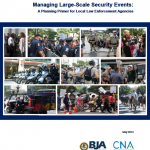
Large-scale events provide local governments with a number of valuable opportunities, including increasing revenue, revitalizing a city, and providing an increased sense of community. With these benefits comes greater responsibility for local law enforcement to ensure the public’s safety. When law enforcement executives are tasked with managing a large event, they can maximize their efforts by learning from other agencies and adopting proven practices. Too often, however, past lessons learned are not documented in a clear and concise manner. To address this information gap, the U.S. Department of Justice’s Bureau of Justice Assistance worked in partnership with CNA to develop this Planning Primer.
